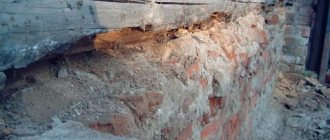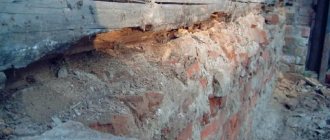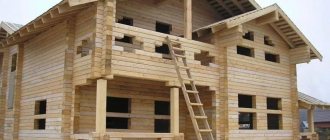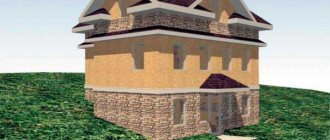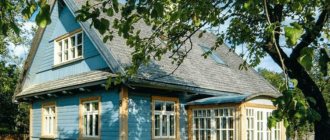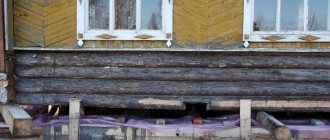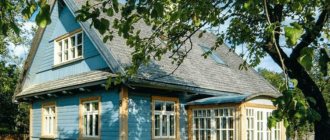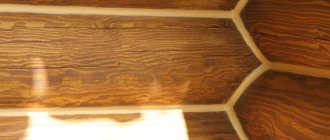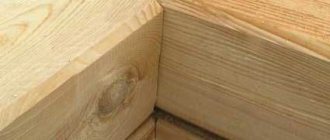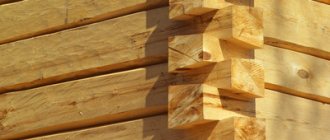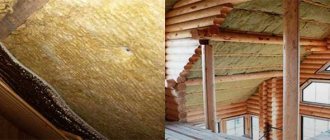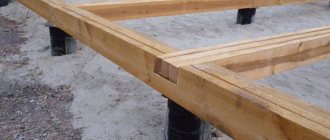Wooden houses are environmentally friendly and beautiful. In addition, subject to the technology of laying logs and appropriate processing of wood, they are also quite durable. The foundation is the basis for any structure, a wooden house is no exception. The wrong choice of base will lead to the formation of cracks, uneven shrinkage of the house, the appearance of gaps between the logs and even the complete destruction of the building. To decide which foundations for log houses you should best know the type of soil and the characteristics of the future structure.
Log house
When building a house from logs, the following types of foundations are mainly used:
- pile-screw;
- columnar;
- tape;
- monolithic;
- block
Each of them has its pros and cons. To understand which foundation is better, you should evaluate their characteristics and installation methods.
Monolithic foundation
Monolithic base
This type of base is a monolithic reinforced concrete slab and is the most expensive. Due to the fact that it follows the seasonal movement of the soil, it is called “floating”. Because of this, it is applicable to almost all structures, regardless of the type of soil and is able to withstand any load. However, before starting construction work, you should determine the groundwater level, the planned weight of the house and the type of soil.
- The construction of the foundation begins with clearing the site and digging a shallow pit (about 20-30 cm).
- Gravel and sand (10-20 cm high) are placed in the resulting depression, watered and thoroughly compacted.
- Waterproofing is laid on the prepared base to protect the slab from moisture.
- Then the formwork is installed.
- Next comes the installation of a frame made of steel rods. Basically, two layers of reinforcing mesh with a rod thickness of 12-16 mm are used. All this is held together with wire. The ends are insulated.
- After this, they begin pouring the concrete mass. The foundation for a log house is poured in one stage, otherwise its strength may suffer. The concrete is evenly distributed between the reinforcing bars. It will gain its strength within 1.5 months from the moment of pouring.
The grade of cement must be at least M300. The thickness of the slab depends on the building design. To build a house from logs, a slab up to 300 mm thick is required.
Sometimes inexperienced builders use a different type of foundation to build extensions. This is fundamentally wrong. It is strictly not recommended to combine a monolithic base with other types. Seasonal soil movement will cause the foundation for the log house to shift, and if there is a different type of foundation under the extension, then the ground movements will lead to a skew of its roof.
How to pour a foundation for a log house
When installing concrete tape, order:
1. Mark the area. Design width and length plus 0.5 m for formwork.
2. Cut the crap.
3. Dig a pit 20 cm deeper than the soil freezes (the last figure for a given region can be taken from the SNiP tables). If there is no basement, then a trench is enough. Its width is determined according to calculations, but should not be less than the thickness of the wall with a margin of 10 cm (average 40 cm). A trench was dug along the perimeter of the house and under the internal load-bearing walls.
4. Pour sand into the pillow, fill it and pour water on it.
5. The heads of the nails should be placed inside the future structure (this will make it easier to remove the formwork). The nail heads should be placed inside the future structure (so the formwork will be easier to remove). The ends of the boards are connected with self-tapping screws.
6. Install screens in the trench. Their height should be higher than that of the future strip. Secure with supports from the outside, with ties on top.
7. Place roofing felt or parchment paper inside so that the grout does not leak out of the cracks and is not absorbed into the slabs.
8. The reinforcement frame is installed in such a way that its edges do not reach 3-5 cm from the formwork. Reinforcement will require 1.2 cm of ribbed rods. The longitudinal bars are arranged in two or three rows (depending on the height of the strip).
9. Cross beams and vertical posts must be tied to longitudinal posts at intervals of 40 cm.
10. Attach the second and third tiers to the verticals: also longitudinal rods and lintels. Both the upper and lower edges of the frame should not extend beyond a few centimeters from the edges of the future strip.
11. To create ventilation, place pieces of plastic or asbestos-cement pipes with a length of about 10 cm inside perpendicular to the slabs. They are positioned with a slight slope towards the street, so that the resulting condensation flows outwards, but not inwards. Fill them with sand so that the pipes do not collapse under the weight of the concrete.
12. To prepare the solution yourself, use cement M200 - 400. The proportion is from one part to 3 sand and from 5 to 6 crushed stone. In cold bottling, the water is heated before mixing.
[goo_r]
13. It is recommended to pour the strip in one day. Pour in layers, compacting each batch. The finished filling is punched in many places with a metal rod to release air.
Columnar foundation
Columnar base
This base option is the most economical. It cannot be used on heaving, unstable soils. Suitable for building houses on surfaces with plane differences of no more than 2 meters.
A columnar foundation for a log house is mainly used for light frame buildings or verandas. The pillars are made of brick, wood, asbestos pipes, concrete, stone or reinforced concrete. You can purchase ready-made concrete blocks. They are located in the corners of the building with an interval of 1.5-2.5 meters. And also under frame racks and at the intersections of walls.
Before constructing such a foundation, the depth of soil freezing should be determined.
The laying of pillars depends on this. Depending on the depth of freezing, it will be 10-30 cm. The depressions are filled with crushed stone and formwork is installed. Polyethylene or roofing felt is used as waterproofing. When properly installed, a columnar foundation for a log house is resistant to any frost.
Optimal foundation: costs for further operation
When choosing a foundation for a log house, we are guided by a number of criteria:
- compliance with load-bearing capacities;
- life time;
- material costs;
- complexity of installation;
- operating costs.
A foundation that meets standard standards does not require special maintenance during the operational period. It is only necessary to monitor the condition of the blind area, promptly clear the area of snow and overgrowth, and limit excavation work near the house. If, during the laying of the foundation, calculation errors were made and a set of waterproofing and insulation work was not completed, then negative consequences are possible in the form of cracking of concrete, the appearance of mold and mildew on the floor and walls. Taking this into account, we can summarize that the costs of a high-quality foundation pay off during the operational period.
Strip foundation
Strip foundation
A strip foundation for a log house is suitable for sandy, sandy-rocky or gravel soil types. To build such a foundation you do not need a large pit. The laying depth for central Russia on non-heaving soils should be 60-80 cm, and on heaving soils - about 1.5 meters. The width of the tape is slightly larger than the width of the wall and is about 30-40 cm.
A strip foundation is made along a closed contour.
- To do this, markings with ropes are made along the entire perimeter of the site according to the project.
- The top layer of soil is removed and a trench about half a meter deep is dug. When groundwater is close, it is increased.
- The trenches under each wall are lined with polyethylene film.
- Washed coarse sand is poured on top of the polyethylene, moistened with water and compacted.
- A wooden formwork is created and a reinforcing mesh of rods 10-12 mm in diameter is mounted into it, fastened with wire so that 30 cm cells are formed.
- A concrete mixture of crushed stone, sand and cement is prepared and poured in a ratio of 5: 3: 1. To evenly distribute the mixture between the reinforcement, it should be stirred with a shovel.
- Drying the base takes at least a month. To prevent drying out, the concrete is covered with damp burlap. And during rain, they are protected from getting wet by covering with polyethylene.
A strip foundation for a log house is very convenient in construction and much more economical than a monolithic one.
Plinths of a log house (building)
Before laying the first crown of rounded logs, it is necessary to waterproof the foundation.
The basement plays a significant role in the operation of the building and is a continuation of the foundation. The basement part of the structure rises above the ground and the temperature in the house and the level of humidity depend on its quality. In small houses, the basement is often the ground part of the foundation, but its height is rarely more than 50 cm. The basement can reach 1.5 meters or more and becomes the lower basement floor of the building. In such a basement you can equip a basement for storing vegetables, a garage, and even make a heated room for various purposes.
To install the base, it is recommended to use high-quality materials that can withstand any weather conditions, including rain, snow, repeated freezing, ultraviolet rays, hail, etc. Therefore, brick, rubble concrete, stone and some other building materials are more often used. In appearance, the above-ground part of the base can be sinking, that is, located deeper than the outer part of the wall, protruding - protruding beyond the edge of the house or being flush with it.
During the construction of the basement, it is advisable to insulate it, for example, with modern perforated insulating panels, which perfectly ventilate the basement space and at the same time are a good heat-insulating material.
Pile-screw foundation
Pile-screw foundation
Installation of such a foundation takes little time and can be used for any type of soil, even loose ones. Piles are made of high quality steel with anti-corrosion coating. The structures look like a metal pipe with a pointed end. Their thickness depends on the load on the foundation. The material is selected for each specific building and piles are sometimes made to order.
Pile foundations for log houses are economical and easy to install.
- After calculating the number of piles, the location for installing the piles is determined. There is no need to clear the site. This foundation allows installation on any landscape.
- In the places designated for screwing in the piles, recesses are made. Then, using the principle of a screw, the structures are screwed in manually or using machines. Piles have a screw and blades with which they are screwed into the ground. Once the tip of the pile touches solid soil, the process is considered complete.
- Excess parts of the pile are removed and concrete is poured.
The foundation makes it possible:
- build a foundation on soft soil;
- build a house on a slope;
- build when groundwater lies close to the surface.
Pile-grillage foundation.
- concrete mixer;
- shovels;
- grinder for cutting reinforcement;
- Master OK;
- level;
- hammer.
This is an ideal option for lightweight wooden houses. It is often laid to great depth. This is done in cases where the soil is characterized by its weakness and is not able to withstand heavy loads. Such loads include high groundwater levels, quicksand and deep freezing of heaving soils.
Scheme of reinforcement of a pile-grillage foundation.
Scheme of reinforcement of a pile-grillage foundation.
When laying the foundation, piles are installed at all corners of a wooden house at a depth of 2 m. In addition, they are installed at the intersections of walls, under frame racks, load-bearing walls and in other places where there is a high load. The piles need to be installed at a distance of 1.5-2.5 m from each other. For the strip base, monolithic, reinforced piles are used. Builders also use asbestos pipes with concrete filling.
There is 1 more type of pile foundations. These are quickly erected pile foundations with a grillage. The pile foundation has permanent formwork. In addition to piles, there are grillages or beams at the base. The upper part of the pile is attached to the grillage with a gap above the ground of up to 10 cm. This will add rigidity to the structure. The construction of this type of foundation for a wooden building requires a small budget and is built very quickly.
Block foundation
Block foundation
The construction of a block foundation for a log house will not take much time. The use of ready-made blocks gives the advantage of not having to wait for the foundation to dry out. This process usually takes two or more weeks. These types of bases are applicable on almost any type of soil. The finished blocks are equipped with correctly selected fittings.
Advantages of a block foundation:
- Frost resistance. The blocks can be used in regions with large temperature fluctuations due to the fact that special additives are mixed into the concrete.
- Good resistance to acidic soils. This allows them to be used on problem soils. For this purpose, the blocks contain crushed granite stone, which ensures this property.
- Large selection of product sizes. The manufacturer provides a wide selection of block sizes. There are large blocks for high-rise buildings and small products weighing 30 kg, which can be installed without the use of special equipment.
Foundation construction process:
- First, you should dig a pit for laying the foundation. To do this, you should make markings with pegs and tape, and hire equipment.
- Prepare the bottom of the pit. If there are soils of unknown quality at the bottom of the pit, it is better to make a sand cushion of about 15 cm and then compact it.
- Both columnar and strip foundations are built using the same masonry technique.
- The solution is prepared just before work. The strength of the foundation directly depends on its quality. Water should not be added to the solution, as this will worsen the adhesion of the structural elements.
- The masonry is made according to the type of brickwork. You should fill the seams with mortar very carefully, leaving no gaps. The thickness of the seams should be 10-15 mm.
Preparing the foundation before assembling a wooden house
Before starting to assemble the lower crown of a wooden house, it is necessary to properly prepare the foundation of any type. The bottom of a log structure is more susceptible to destruction due to wood rotting. Therefore, it is necessary to prevent this process. To do this, before assembling the house, the foundation must be isolated from the wood with waterproof material.
This is especially important for concrete structures. The capillary effect forces moisture to rise through the concrete to the top, which can lead to wetting of the wood and accelerate the process of its destruction. A layer of waterproof material blocks contact between the wet foundation and the wood, but it must be overlapped to prevent water from penetrating through the joints of the material.
Even the presence of a waterproofing layer is unable to completely protect wooden parts. To increase their service life, the lower parts of the structure must be treated with antiseptic solutions. This applies not only to the lower crowns of the building, but also to the foundation frame, if it is made of wood.
In this case, it is advisable not just to coat the boards for tying with an antiseptic, but to completely immerse them in the solution, saturating the pores of the wood. This will significantly reduce wood rot and prevent pest damage.
Also, when preparing the foundation, do not forget that in order to increase the service life of the house, its lower edge should not be located closer than 50 cm to the ground surface. In addition to the capillary effect, soil evaporation affects the tree. Steam rising from the ground soaks into the wood, dampening it and increasing the risk of decay.
